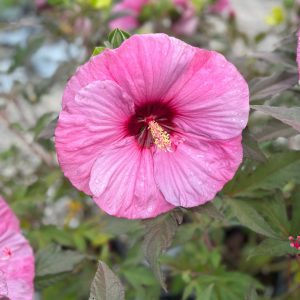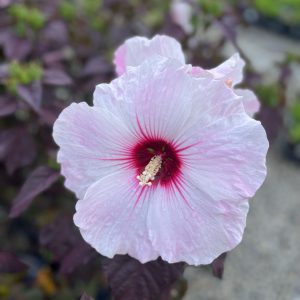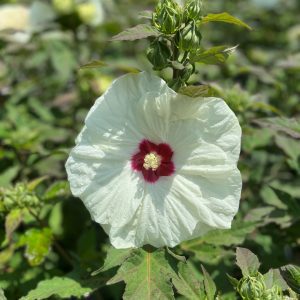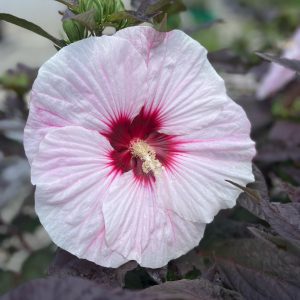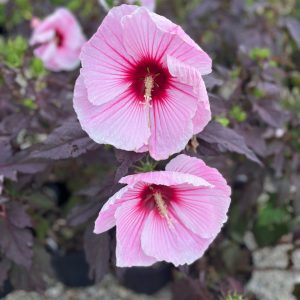Hardy Hibiscus, Rose Mallow, Swamp Mallow, Hibiscus moscheutos
If you’re looking for a beautiful, long-blooming flower to add to your Alabama garden, look no further than the hardy hibiscus! These magnificent blooms come in a variety of colors, and can be grown in almost anywhere in Alabama. In this blog post, we will discuss how to grow and care for these flowers. We’ll also provide tips on choosing the right variety for your needs. So read on to learn more about these amazing plants!
What are Hardy Hibiscus?
Hardy Hibiscus, distinguished from their tropical counterparts, are a group of perennial plants known for their ability to withstand colder temperatures and large, showy blossoms. Here’s an in-depth look into these resilient and captivating plants:
- Scientific Classification and Varieties:
- The term “Hardy Hibiscus” encompasses a variety of Hibiscus species native to Alabama, with the most common being Hibiscus moscheutos.
- Other species within the Hardy Hibiscus label include H. coccineus (scarlet rose mallow), H. dasycalyx (Neches River rose mallow), H. grandiflorus (swamp rose mallow), H. lasiocarpos (hairy or wooly rose mallow), and H. laevis (halberd-leaf rose mallow).
- Physical Characteristics:
- They are known for their large, eye-catching blossoms, often compared to the size of a dinner plate, that they flaunt from midsummer to early fall.
- These plants can grow to a height of 3-6 feet, adding a dramatic visual element to gardens.
- Climate Adaptability:
- Hardy Hibiscus can endure cold winter temperatures as low as -30°F (-34°C). In regions with harsh winters and snow, they die back to the ground, rejuvenating in the spring.
- They are well-suited for colder climates, and their resilience in chilly weather makes them stand out, especially when compared to tropical hibiscus varieties which thrive in warmer climates.
- Cultivation and Care:
- These plants require minimal care and are known to attract hummingbirds and pollinating bees, while generally deterring deer.
- Garden Appeal:
- The Hardy Hibiscus is not only a symbol of endurance but also of aesthetic appeal. The vibrant, large blossoms can transform gardens, bringing a tropical ambiance to temperate landscapes. They are often grown for their color, disease tolerance, and cold hardiness, with numerous cultivars bred for these traits.
Hardy Hibiscus offers a blend of robustness and beauty, embodying a perfect choice for those looking to add a touch of the tropics to their gardens while not compromising on hardiness.
Where to Plant Hardy Hibiscus?
Planting Hardy Hibiscus in the right spot and providing them with the conditions they love can ensure healthy growth and a long, beautiful display of blossoms. Here are some guidelines on where to plant Hardy Hibiscus:
- Planting Location:
- Hardy Hibiscus plants thrive in full sun locations; they require at least 6 or more hours of direct sunlight per day.
- Consider planting them near a south-facing wall or building as they enjoy heat.
- They can be planted along or in the back of perennial flower beds, in borders, mixed perennial beds, or used as a standalone specimen plant.
- Spacing:
- When planting multiple Hardy Hibiscus, ensure to space the plants 2 to 3 feet apart in the garden to avoid overcrowding and to allow for ample growth.
- Soil Conditions:
- Hardy Hibiscus plants prefer well-draining soil with a pH range that is slightly acidic to neutral.
- They are quite tolerant of a wide range of soil conditions, from drier to even moist or boggy, but best flowering is achieved when there is ample moisture.
- Additional Tips:
- For gardeners in North Alabama, ensuring the planting area is well-draining will prevent water logging in the soil which could potentially harm the plants during winter months.
How to Care for Hardy Hibiscus in Alabama?
Caring for Hardy Hibiscus plants is a relatively straightforward process but requires attention to a few key factors to ensure healthy growth and blooming. Here are some steps and tips on how to care for Hardy Hibiscus:
- Watering:
- Water enough to keep the soil evenly moist, especially as the plant is getting established for the first six months. Water regularly during dry spells to maintain a healthy plant.
- Fertilization:
- While Hardy Hibiscus doesn’t absolutely require fertilizer, applying a general-purpose fertilizer will promote vigorous growth.
- Mulching:
- Mulching around the base of the plant can help retain soil moisture, suppress weeds, and improve soil quality.
- Pruning:
- Pruning can be done to maintain shape and encourage bushiness. It’s also important to remove dead or damaged branches to promote healthy growth.
- Pest and Disease Management:
- Keep an eye out for common pests like aphids and whiteflies, and diseases such as rust or powdery mildew. Employ cultural, biological, or chemical controls as necessary to manage these issues.
By following these care guidelines, gardeners can foster a conducive environment for Hardy Hibiscus to flourish, ensuring a vibrant and attractive display in the garden season after season.
What do you do with hardy hibiscus in the winter?
Hardy Hibiscus, unlike tropical hibiscus, are capable of withstanding colder temperatures to a certain extent, which makes winter care for them a bit easier. North Alabama, you may need to provide additional protection, such as wrapping the plant in burlap or placing it in a protected area. Central and South Alabama should need no protection. However, there are some steps you can take to ensure they thrive and return with robust growth in the spring:
- Mulching:
- Apply a thick layer of mulch (8 to 12 inches) around the base of the plant to help protect the root ball from cold temperatures. Chopped leaves or pine needles are great choices for mulching material.
- This mulch acts as an insulating sheet that keeps the soil warm and prevents early new growth until the warmer seasons.
- Pruning:
- In the fall, before applying mulch, prune dead stems or branches down to about 8 to 12 inches. This helps to tidy up the plant and prepare it for winter.
- Once spring arrives and you are certain that there’s no danger of hard freezes, remove the mulch. If any branches have been damaged over winter, cut these to the ground. As new growth appears, you can trim and shape the plant as desired.
- Winter Hardiness:
- Hardy Hibiscus are root hardy to about zone 5 with no protection and they die back to the ground each year. This natural die-back helps the plant conserve energy and withstand colder temperatures.
- Patience:
- Hardy Hibiscus are known to be slow starters in the spring, so patience is key. Once the warmer temperatures settle in, you’ll see your Hardy Hibiscus beginning to grow and prepare for a new season of blooming.
- Indoor Overwintering (for Potted Plants):
- If your Hardy Hibiscus is potted, it’s easier to bring it indoors to protect it from freezing temperatures. Ensure it is placed in a well-lit area and keep the soil moist, not wet.
These measures will help ensure the survival and vigor of your Hardy Hibiscus through the winter, and set the stage for beautiful blooms in the following growing season.
With a little care, hardy hibiscus can provide you with beautiful blooms for many years to come! So don’t hesitate to add these plants to your garden today.


